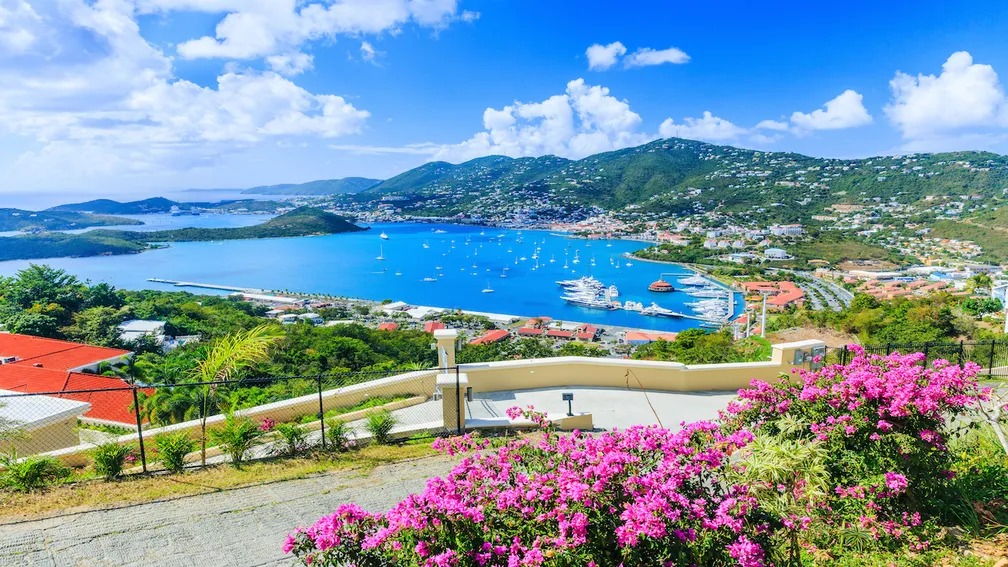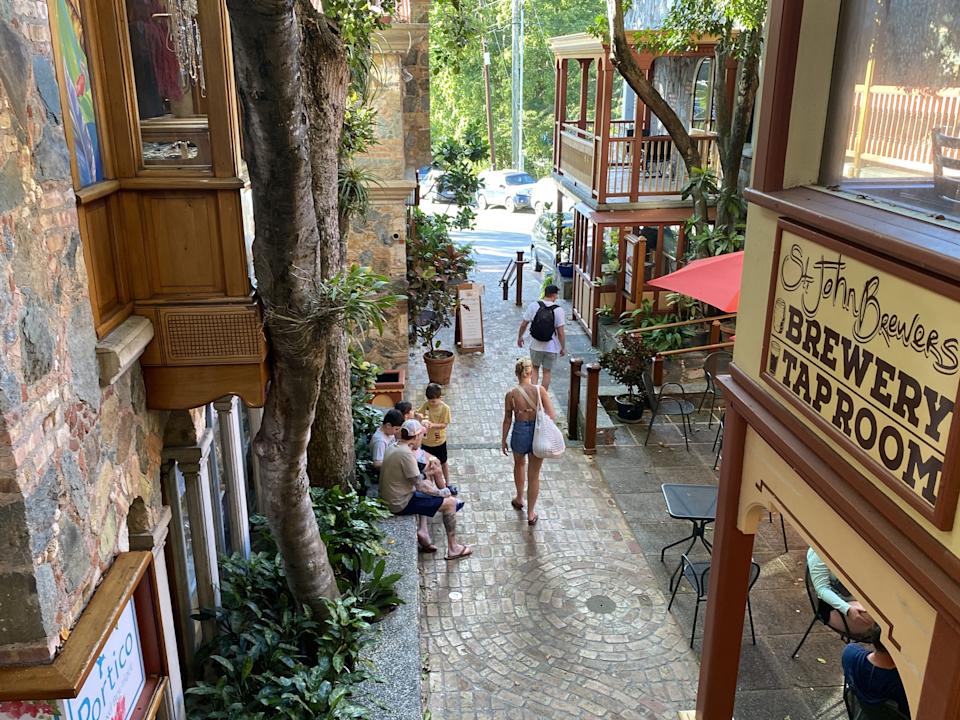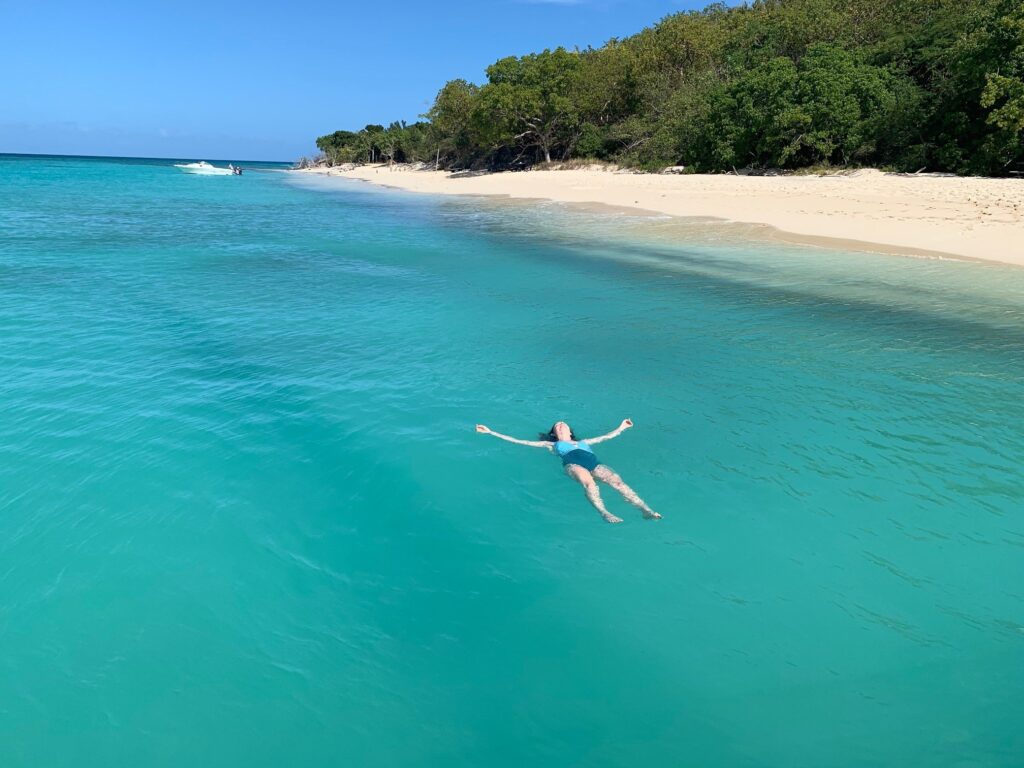CRUZ BAY — The beaches of the U.S. Virgin Islands dazzle with light and color. Tropical breezes drift across palm-lined bays.
The three main islands – St. Thomas, St. John and St. Croix – shimmer under blue-sky days and starry nights in paradise. Warm hospitality complements the natural beauty. Islanders routinely greet each other in passing on the street and share a passion for positive living. Diverse cultures converge, creating rich, jazzy island vibes.
The U.S. Virgin Islands, located east of Puerto Rico, have a population of around 100,000. More than 2 million visitors come to the islands annually; about one half arrive on cruise ships. They come to enjoy water sports, shop at duty-free stores, devour Caribbean cuisine and tour historic sites.
The islands have a long, storied history, beginning with nomadic people arriving about 3,000 years ago, followed by the Arawak and Carib peoples. Christopher Columbus set foot here on his second voyage to the Americas in 1493. A string of other European explorers laid claims, including the Danes, who established a colony and built forts, towns and vast plantations for sugarcane and cotton. Their era ended in 1917 when events of World War I prompted the United States to purchase the 50-plus islands, islets and cays for $25 million in gold.

St. Thomas
“Look, a green sea turtle!” shouts a Night Kayak guide as he shines his flashlight at the animal swimming just 15 feet away. “It’s a big one.”
Green sea turtles can grow to four feet long and weigh more than 350 pounds. We spot many amazing sea creatures as we paddle small, clear-bottomed kayaks with lights around Pacquereau Bay. We observe stingrays, large tarpons, sea urchins and even ballyhoos along this coral-lined bay. A small, silvery ballyhoo startles paddlers when it jumps out of the water and lands in their glowing boat.
The outing in Pacquereau Bay unfolds under a star-lit sky with a string of golden lights along the shoreline of Charlotte Amalie. During the day, the capital and largest city of the U.S. Virgin Islands overflows with shoppers and sightseers. Gift boutiques, restaurants, bars and hotels flourish in the harbor and shopping districts. Main Street’s fashion and jewelry stores are dominant draws.
Fort Christian, the oldest standing structure on St. Thomas, with construction begun in 1672, presides over the waterfront. The bold-red building housed the Danish government’s treasury; its cannons deterred pirates. The fort’s importance shifted, and by 1874 it held prisoners instead of militia and governors. Now history exhibits occupy the rooms, secret passageway and dungeon.
The fort’s Victorian-era clock tower overlooks the Emancipation Garden, a tribute to the perseverance of enslaved Africans who emerged from bondage in 1848. A bronze statue depicts a man blowing a conch shell, a method of signaling during the fight for freedom.
A dynamic chapter of Caribbean history is revealed at Pirates and Treasure: A Shipwreck Museum. St. Thomas was a favorite refuge for buccaneers in the late 17th and early 18th centuries. The museum tells the stories of notorious Blackbeard, Bluebeard, Captain Kidd and others. Maps of secret inlets and artifacts from shipwrecks are on display.
Located a block from a busy marina, a small museum is the pride of Frenchtown. The French Heritage Museum illustrates the oft-overlooked history of the French on St. Thomas. The tight-knit community has a vibrant past of cricket players, war veterans and civic leaders. Straw weavings, fish traps, tools, ship models and vintage photographs show the impressive contributions of French settlers.
Fishermen bring their catch to the Petite Pump Room, a waterfront restaurant known for its laid-back atmosphere. The long-established, family-owned restaurant offers a menu of authentic Caribbean cuisine, including conch fritters. The bar serves specialty tropical drinks.
A popular pastime for visitors is a driving tour on Skyline Drive. St. Thomas’ terrain ascends 1,500 feet to Mountain Top. Sweeping northside views appear of the mesmerizing blue Atlantic Ocean, Magens Bay and the British Virgin Islands. Local lore claims English privateer Sir Francis Drake came to this overlook to survey cargo ships, hence the landmark Drake’s Seat. Magens Bay’s white-sand beach is ranked annually among the world’s top 10 beach destinations.
We view the south side of the island from the pool terrace at the Pink Palm Hotel. Palm trees frame the vista of orange-tiled roofs of Charlotte Amalie, flowing green hills and shimmering bay. We savor our dinner of grilled shrimp with creole sauce at the hotel’s El Barsito restaurant as the town lights glow at twilight.

Vacationers stroll through Mongoose Junction, a retail enclave on St. John, U.S. Virgin Islands. Art galleries, home decor boutiques, clothing shops, bars and restaurants cluster around tropical garden spots. The popular destination is near the St. John ferry dock at Cruz Bay,
St. John
Snorkelers follow an underwater trail at Trunk Beach while sun bathers enjoy the most popular of three primary beaches in Virgin Islands National Park on St. John. The azure water seems to change color with the breeze.
Getting to St. John involves a 20-minute ferry ride from Red Hook on the east end of St. Thomas to Cruz Bay. Then, a taxi drive along the narrow, steep North Shore Road introduces panoramic coastal views.
Virgin Islands National Park and Coral Reef National Monument preserve a variety of mountainous and underwater habitats. We glimpse a mongoose at Cinnamon Bay Beach and deer at Annaberg Sugar Plantation overlooking Leinster Bay. A windmill centers the plantation ruins, a remnant from the era of sugar production. At Cinnamon Bay, vestiges remain of a ceremonial site of the Taino people who lived on St. John from about 1100 to 1500.
A short ride away, the view stretches for miles from the Windmill Bar over Hawksnest Bay. Musicians perform in the evenings at this open-air eatery. A banner for East Tennessee’s own Kenny Chesney hangs above tables. St. John grabbed international headlines in 2005 when the country singer married Oscar-winning actress Renee Zellweger at Peter Bay, an exclusive gated community on the north shore.
In Cruz Bay, a carnival of flavors enhances the fine dining experience at Morgan’s Mango. We feast on coconut panko-encrusted fresh grouper. Mongoose Junction, a dining, drinking and shopping district, also offers Caribbean specialties. Island rum is the preference of evening partiers who sip in flip-flops at bars as the evening cools.

St. Croix
A barracuda swims among the many tropical fish around Buck Island Reef National Monument. A half-day cruise with Big Beard’s Adventure Tours takes us to a snorkeling trail where bright angel fish, parrotfish, sergeant major and blue tang abound in canyons of coral. More than 250 varieties of fish live in this habitat. A white coral sand beach stretches across the southwest side of the island; and a short, but steep hiking trail yields spectacular views of the turquoise seascape.
We arrive at St. Croix after a 20-minute flight from St. Thomas. At 84 square miles, the island is the largest of the three, and the lay of the land is flatter, allowing for farms and open spaces.
Visitors awake early to be among the first to see the sun rise over American territory at Point Udall on the island’s eastern edge. There, triangular Millennium Monument casts long shadows as daylight peeks above the horizon.
The historic town of Christiansted clings to the Caribbean coast. The King’s Wharf at this former capital was the hub of international commerce during and after Danish rule. Islanders brought sugar, rum and cotton to the docks for shipment. Manufactured goods, lumber, domestic animals and enslaved workers arrived to supply residents.
Construction on Fort Christiansvaern was finished in 1749 to protect Christiansted from pirates. The butter-colored fort, Customs House, Scale House, Steeple Building, warehouse and bandstand make up the Christiansted National Historic Site.
The town is the boyhood home of U.S. Secretary of the Treasury Alexander Hamilton. As a nod to Hamilton, we have a traditional American bacon-and-eggs breakfast at Caroline’s, a cozy eatery at the wharf. Later in the day, we toast Hamilton’s success with Island Life beer at Leatherback Brewing Company.
East of Christiansted’s town center, the Buccaneer Resort sits on 340 acres and encompasses two pools, three beaches, eight tennis courts and an 18-hole golf course. The Buccaneer also offers fine dining at The Terrace restaurant and the Mermaid on the beach. The views of Altona Lagoon and Beauregard Bay complete the picture of a perfect island resort.
St. George Village Botanical Garden, in the island’s western region, was built on the site of Estate St. George, a sugar plantation. The garden has more than 1,500 plants including a large orchid garden. The Great Hall is a popular venue for community events, including the family-friendly Mango Melee, a celebration of the abundant mango trees grown on St. Croix.
Colors dance on the canvases of the Caribbean Museum Center for the Arts in Frederiksted. Bright yellow, green, aquamarine and fuchsia splash across exuberant paintings of flowers, native beauties and landscapes. Some artists select fabrics, metal and wood to create works reflecting tropical themes.
The museum is located in the Frederiksted Historic District, a park-like setting along the deep harbor. A palm-lined promenade with flowering shrubs leads to the Frederiksted Pier and Fort Frederiksted, a National Historic Landmark.
Linda Lange and Steve Ahillen are travel writers living in Knoxville, Tennessee.
This article originally appeared on Knoxville News Sentinel: Travel: US Virgin Islands offer dazzling beaches, color, history



